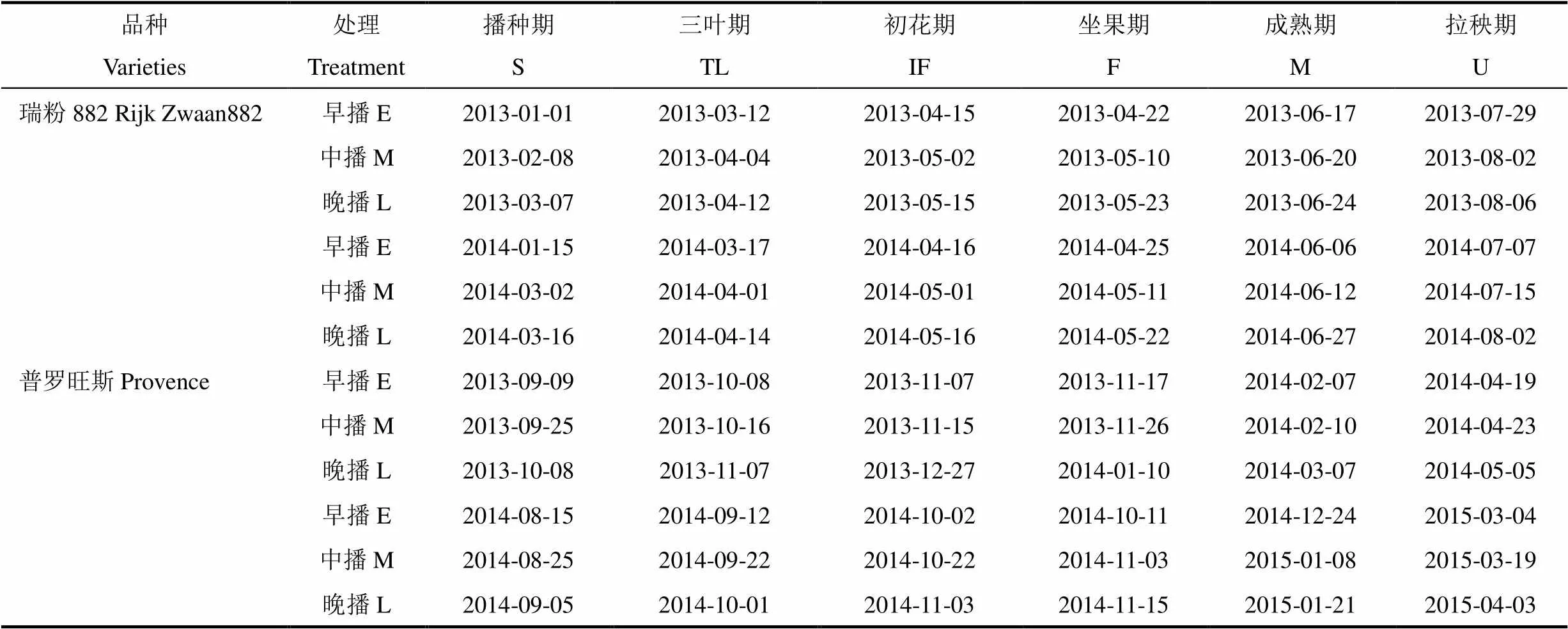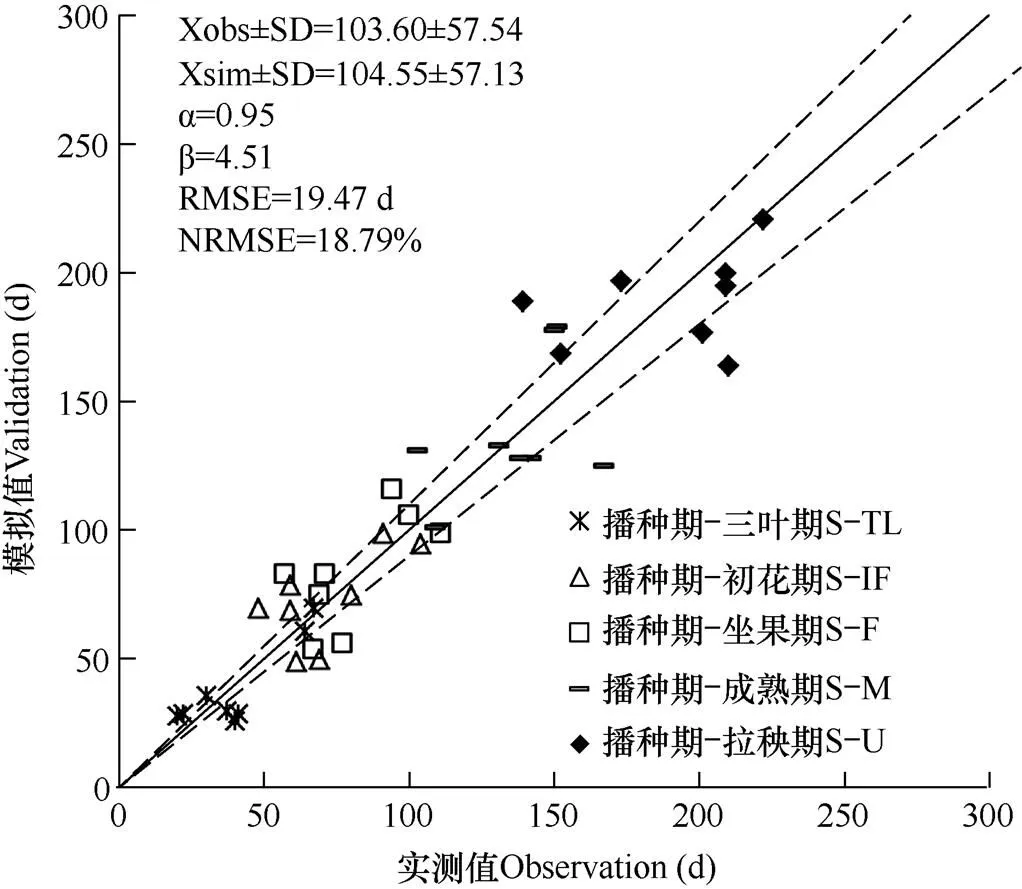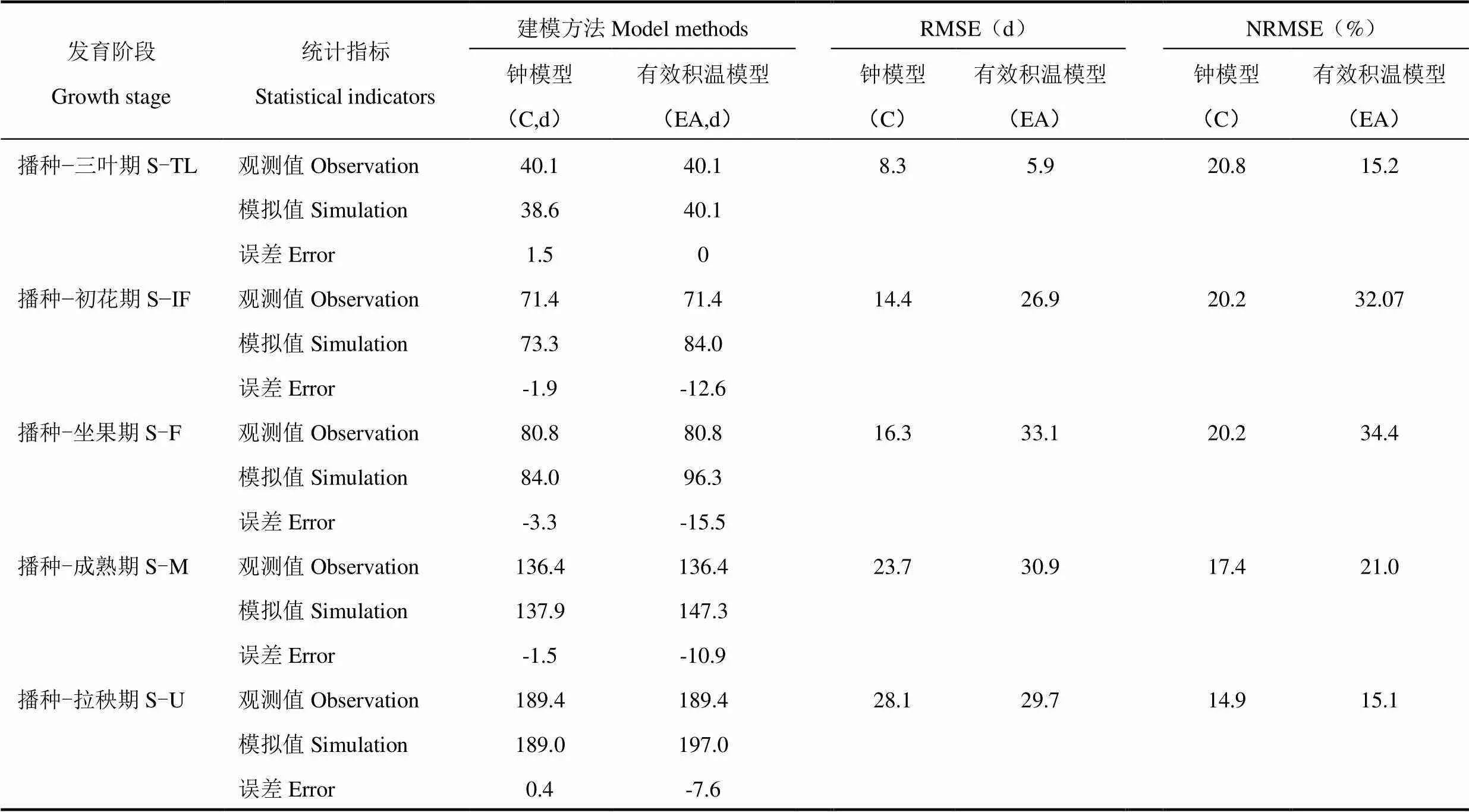钟模型在日光温室番茄发育进程模拟中的适应性探讨*
2020-10-23温永菁董朝阳刘淑梅宫志宏黎贞发冯利平
温永菁,李 春,董朝阳,程 陈,刘淑梅,宫志宏,黎贞发,冯利平
钟模型在日光温室番茄发育进程模拟中的适应性探讨*
温永菁1,李 春2**,董朝阳2,程 陈3,刘淑梅2,宫志宏2,黎贞发2,冯利平3
(1.天津市静海区气象局,天津 301600;2.天津市气候中心,天津 300074;3.中国农业大学资源与环境学院,北京 100193)
依据日光温室番茄生长发育的光温反应特性,基于2个番茄品种不同播期12个生长季的发育阶段日数、温度和日照时数观测资料,利用钟模型中相关数学指数表达式表征番茄的不同发育时期和发育进度,将番茄的发育时期指标化。随后对各个发育阶段的模型参数进行求解,得到基本发育系数、温度反应特性遗传参数和光照反应特性遗传参数等模型参数初值,对模型进行统计检验和调试,使模型的模拟值与实测值之间误差最小,由此得到模型参数终值,建立基于钟模型方法的温室番茄发育期模拟模型。经验证,该模型在播种−三叶期、播种−初花期、播种−坐果期、播种−成熟期和播种−拉秧期5个番茄发育阶段模拟值与实际观测值之间的回归估计均方根误差(RMSE)分别为8.3、14.4、16.3、23.7和28.1d;回归估计标准均方根误差(NRMSE)分别为20.78%、20.18%、20.21%、17.35%和14.86%,表明本模型模拟效果较好。将钟模型模拟结果与有效积温法模拟结果进行对比,钟模型对各个关键发育期的模拟精度更高,模拟效果更好。
温室;番茄;钟模型;发育期模拟
番茄是重要设施栽培蔬菜之一。在番茄的设施生产中,影响其获得高产和优质生长发育的重要因子除了品种的遗传特性及水肥管理外,温度和光照等气象环境条件也是重要的影响因子,实际生产中常通过调控温度和光照以获得有利气象环境条件,从而达到高效生产的目的。因此,模拟温室番茄发育进程与环境条件的关系,实现温室番茄栽培和环境调控优化管理,提高温室番茄生产经济效益具有重要的科研和现实意义[1-3]。
国外对于温室蔬菜生长发育模拟模型研究较早,取得了一定成果。其中,关于番茄发育进程有代表性的模拟模型有HORTISIM(Horticulture Simulator)模型、TOMSIM(Tomato Simulator)番茄生长发育动态模型和TOMGRO(Tomato Growth)番茄生长发育模型[4-11]。国内设施园艺模型起步较晚,其中齐维强等进行的温室番茄生长发育模型研究主要采用积温法,利用经验方法和回归分析研究温度对温室番茄不同发育期的影响[12-14];曹卫星等基于生理发育时间法(Physiological Development Time,PDT)分别建立了温室番茄和黄瓜发育期模拟模型[15-17];邹薇等主要考虑温度对温室番茄发育速度的影响,分别提出了基于线性分段函数、正弦指数分段函数和指数函数来计算生理发育时间的温室番茄生长发育模型,获得的结果较准确[18-20]。虽然目前国内外在番茄生长发育模拟模型的品种和建模方法方面已取得一系列进展,但多为典型的统计经验模型,其机理性和普适性仍需加强。
钟模型最早是由高亮之等开发应用于水稻生长发育进程的模拟模型,作为比较有代表性的大田作物模型之一,以同时考虑作物发育期长短以及营养生长性、感温性、感光性等遗传特性和环境因子两方面为优点,被广泛应用到模拟小麦、棉花、玉米等大田作物研究中[21-25]。近几年,钟模型被借鉴应用到一些经济作物中,周静等借鉴水稻钟模型,构建了描述温室水果黄瓜不同植株叶龄、不同位置叶片获得干物质量模拟模型[26];程陈等构建了基于钟模型温室黄瓜发育模拟模型[27],陈潇等基于钟模型建立了甘蔗发育期模拟模型[28]。
本研究以钟模型为基础,将各个发育阶段的影响因素归因于温室内的空气温度和日照时数,归纳番茄各个发育阶段的三基点温度,构建“瑞粉882”和“普罗斯旺”两个北方常见温室番茄品种的发育进程模拟模型,并通过不同播期番茄的试验数据对模型进行检验,确保模型具有准确性和普适性,以期为温室番茄种植用户确定种植时间、上市时间以及管理和调控提供指导,进而达到提高番茄种植经济效益的目的。
1 材料与方法
1.1 试验设计
试验于2013-2015年在天津市农业科技创新基地日光温室(116.97°E,39.43°N,海拔8m)内进行。该温室为典型二代温室,墙高3.7m,墙体厚度50.0cm,脊高5.3m,后屋面仰角44.0°,前屋面角32.0°,跨度10.0°,长度65m,占地总面积650.0m2。试验供试品种为“瑞粉882”和“普罗斯旺”。试验期间共种植4茬番茄,包括2013年和2014年各一次春茬栽培,即冬季播种育苗,春季移栽,品种为“瑞粉882”;2013/2014年度和2014/2015年度各一次秋冬茬栽培,即秋季播种育苗并栽培,品种为“普罗斯旺”。当地常规播种日期,春茬在2-3月播种,秋冬茬在8-9月播种。每茬设3个播期,早播:早于当地常规播种日期15~30d;中播:当地常规播种日期,春茬在2−3月播种,秋冬茬在8−9月播种;晚播:晚于当地常规播种日期15~30d。其中,中播用于建立模型,早播和晚播用于模型检验。每个播期处理设3个重复,采用随机区组排列。各小区栽培行距均为0.67m,株距为0.55m,种植密度为2.71 株×m−2。栽培管理措施按当地常规。
1.2 数据获取
1.2.1 发育期观测
根据番茄生物学特性,结合当地栽培经验,并参考文献[11−14],将番茄的整个生长过程划分为6个关键发育期,定义各发育期相应的形态特征如表1。自播种之日起每隔5d观测1次,临近关键发育期时每日观察,当供试植株中有不少于50%植株表现出某发育期的形态特征时,即视为群体到达该发育期。

表1 番茄发育期的划分及其形态指标
1.2.2 气象数据采集
温室内小气候观测选用DZN1型小气候观测仪(天津市产),温度传感器的精度为±0.2℃,测量范围-40.0~50.0℃。温室内空气温度和辐射自动记录频率为1次·10min−1。
1.3 研究方法
1.3.1 钟模型的建立
由于温度和光照因子对番茄的生长发育有重要影响,因此,每个发育阶段都考虑到了这两个环境因子。表达式为[28−32]

式中,DS为发育期或发育阶段的日数(d);k为基本发育系数(Basic development coefficient),由品种自身的遗传特性决定,k值越大,说明该品种发育速度越快,为早熟品种;p为温度反应特性遗传系数(Genetic thermal coefficient),反应该品种在这一发育阶段内对温度的反应敏感性;TE为温度效应因子,反应温度对番茄发育的非线性影响[27−28,33];q为光周期反应特性遗传系数(Genetic thermal coefficient),反应该品种在这一发育阶段对日照时数的反应敏感性;PE为光周期效应因子,反应日照时数对番茄发育的非线性影响。

利用模型中基于一系列参数的数学指数表达式表征番茄的不同发育时期,并在各发育期指数之间通过找到相应的小数值表示各发育时期的发育进度,最终实现将番茄的发育时期指标化。各发育时期内影响番茄发育的主要环境因子及该阶段的基本发育模型都随基因型品种而异。
随后对各个发育阶段的模型参数进行求解,得到模型参数的初值,主要包括基本发育系数、温度反应特性遗传参数和光照反应特性遗传参数,对模型进行统计检验并通过非线性规划中的步长加速法对各个参数进行逐一调试,使模型的模拟值与实测值之间误差最小,由此得到模型参数终值。
发育生理日数(D0)表示品种完成某个发育阶段的基本发育期最短的发育日数[34]。

1.3.2 有效积温模型的建立
预测作物发育期传统的方法是使用有效积温法(Growing degree days,GDD),其最大的优点是模型输入变量只有温度,计算简单,易于实践推广。有效积温法的计算式为[15,29]



表2 番茄不同发育阶段的三基点温度和日照时数
注:Tb为作物生长的下限温度,Tol为作物生长的最适下限温度,Tou为作物生长的最适上限温度,Tm为作物生长的上限温度,Db为临界日照时数,Da为最适日照时数。
Note: Tb is lower limit temperature at which crops grow, Tol is lower optimal temperature at which crops grow, Tou is upper optimum temperature at which crops grow, Tm is upper limit temperature at which crops grow, Db is critical sunshine hours, Da is optimum hours of sunshine.
1.3.3 模型的检验



式中,Xobs和Xsim分别为观测值和模拟值,模拟误差的大小可用RMSE和NRMSE表示,总体模拟效果由模拟值均值与实测值均值的差异反映。当线性回归系数(α)越接近1,截距(β)越接近0,并且决定系数(R2)越大时,模拟值与观测值的吻合度越高。
2 结果与分析
2.1 钟模型的构建
2.1.1 番茄发育期观测结果
根据表3中发育期记录结果可算出,两个品种共12组试验的播种−三叶期、播种−初花期、播种−坐果期、播种−成熟期和播种−拉秧期,平均所需日数分别约为36.9、68.6、78.3、133.3和186.8d。同时,根据实际观测的气象数据计算出各阶段有效积温的平均累积值分别为371.3、517.3、556.7、763.8和1108.5℃·d,因此,以此作为有效积温发育期模拟模型的参数。
2.1.2 钟模型各发育阶段参数确定
对钟模型表达式(式1)两边同时取对数进行线性化,得到

将两个品种中播期处理观测的各发育阶段日数、温度和日照时数观测资料,代入线性方程中,利用最小二乘法求解出模型参数初值,结果见表4。由表可见,两个品种各发育阶段的发育进程均可用钟模型来表达,复合相关系数均通过0.05水平的显著性检验。但是,同时表中也显示,不同品种或同一品种不同发育阶段内,方程的基本发育系数(k)、温度反应特性遗传系数(p)、光照反应特性遗传系数(q)略有差异,说明不同品种在不同发育期对环境温度、光照的反应特性有差异。从两个品种整个生长季模拟方程的系数看,品种间存在较大差异。

表3 2013−2014年两品种番茄不同播期的主要发育期日期记录(年−月−日)
注:E为早播处理,M为中播处理,L为晚播处理。
Note: E is early sowing treatment, M is medium sowing treatment, L is late sowing treatment.

表4 两品种番茄各阶段发育进程的钟模型模拟方程

续表
注:DS为各发育阶段的发育日数,TE为温度效应因子,PE为光周期效应因子。
Note: DS is days of development at each development stage, TE is temperature effect factor, PE is photoperiod effect factor.
2.2 钟模型的验证
2.2.1 与实测值比较
利用得出的参数终值,根据表4各方程对各个发育阶段的发育进程进行计算,与两个品种各发育期实测天数进行比较,对模型进行验证,模拟验证结果见图1。由图可见,播种−三叶期的模拟结果最好,播种−初花期次之,而播种−成熟期的模拟结果最差。这也是由于在初花期之前发育期界限特征较明显,并且为营养生长阶段,主要受光温影响;初花期之后为生殖生长,多重环境因子共同作用,并且植株受授粉、打叉、掐尖儿、采摘等人为农事活动影响,导致模型模拟准确率较低。
由表5可知,播种−三叶期、播种−初花期、播种−坐果期、播种−成熟期、播种−拉秧期的模拟值与实测值的均值分别相差1.5、1.8、2.3、1.5、0.4d,标准差在12.0d以内;各个发育阶段的P值都在0.38~0.49,说明发育期模拟值与实测值之间差异极小;播种−成熟期、播种−拉秧期的NRMSE都在10%~15%,播种−三叶期、播种−初花期、播种−坐果期的NRMSE都在15%~20%,具有较高的模拟精度;播种−三叶期的RMSE在10d以内,播种−初花期、播种−坐果期的RMSE在15d以内,播种−成熟期的RMSE在20d以内,播种−拉秧期的RMSE在30d以内;从α值和β值也可以得出模拟值与实测值的线性关系较显著。综合分析可以得出,钟模型能够较好地预测番茄各个关键发育时期。

图1 各阶段模拟发育日数与实测发育日数的对比
注:虚线方程为y=(1±CV)·x,CV为变异系数,设定值为10%。α为线性方程的斜率,β为截距。下同。
Note: The equation of dotted line is y=(1±CV)·x,CV is coefficient of variation and set the value at 10%. α and β aretheslope and intercept of linear equation, respectively. The same as below.

表5 番茄各发育阶段验证结果的统计指标
2.2.2 与有效积温模型模拟结果比较
根据有效积温模型参数与钟模型参数,对两个品种番茄的各发育阶段进行模拟,统计结果见表6。由表可以看出,钟模型预测误差都维持在3.5d以内,而有效积温法的预测误差在15.5d以内。除播种−三叶期外,钟模型的RMSE和NRMSE均比有效积温法小,钟模型的RMSE在6.8~23.0d,而有效积温法的RMSE在5.9~33.1d。钟模型的NRMSE在12.13%~6.50%,而有效积温法的NRMSE在15.09%~34.38%。总体而言,钟模型的模拟精度优于有效积温法。对于播种−三叶期的模拟,有效积温法比钟模型的模拟精度要稍好,而其余关键发育阶段,钟模型的模拟精度明显优于有效积温法模拟精度。其原因可能是番茄发育初期以营养生长为主,温度为其主要驱动因子,所以前期两种方法的模拟效果均较好,而进入生长中后期,主要驱动因子增多,仅以温度为输入量难以获得较好的模拟结果。

表6 钟模型(用C表示)和有效积温模型(用EA表示)对番茄各阶段发育日数的模拟结果
注:误差=观测值−模拟值。
Note: Error=observation value-simulation value.
综合分析可知,钟模型能够很好地预测番茄各个关键发育期。由于有效积温法忽略了光照等其它重要因素的影响,仅考虑番茄发育速度与温度的线性关系,并且只在发育的生物学下限温度与上限温度范围内给出不同的发育速率,假定番茄发育各个时期对温度的敏感性是恒定的,违背了番茄的实际发育规律,因此有效积温的预测误差偏大。鉴于番茄的发育受温度与日长的影响,本研究建立了番茄发育的非线性模型,经可靠性检验后认为,用这一方法解释番茄的生长发育状况可以得到较高的模拟精度。
3 结论与讨论
3.1 结论
钟模型能较准确地预测温室番茄的发育期,对番茄各生长阶段的模拟值与实测值的RMSE在8.3~28.1d,NRMSE在14.86%~20.78%,而有效积温法模拟值与实测值的RMSE在5.9~33.1d,NRMSE在15.09%~34.38%。综合比较两个发育期模拟模型对各个发育阶段的实测值与模拟值的α值和β值可以看出,钟模型模拟值与实测值之间具有很好的线性关系,RMSE分别为8.3、14.4、16.3、23.7、28.1d,NRMSE分别为20.78%、20.18%、20.21%、17.35%、14.86%,可见钟模型的模拟精度要优于有效积温模型。
3.2 讨论
(1)在试验数据获取方面,根据2013-2015年试验数据建模并检验,后续可坚持多年试验,补充数据量,调整模拟模型参数,进一步提升温室番茄发育进程模拟模型准确率。此外,本研究仅获取了天津地区的两个代表性品种发育期数据,实际温室番茄在全国的种植面积与种植品种都较多,还需进一步在控制环境下在更多地区进行不同基因型品种比较试验来完善模型对更多地域基因型的品种普适性。
(2)在研究方法方面,关于影响番茄发育期的环境因素方面考虑仍不够全面,例如播种深度、施肥等农业措施的影响未考虑到模型中,还需进行控制环境下的试验研究来证实和修订。
(3)在模型精度方面,温室番茄发育期模拟与经典的积温模型模拟法进行比较,后续研究可与其它温室番茄发育进程模拟模型方法进行对比分析,并对不同方法的结果进行集成分析,以优化温室番茄发育期模拟模型。
[1]Al-Ismaily S S,Al-Yahyai R A,Al-Rawahy S A.Mixed fertilizer can improve fruit yield and quality of field-grown tomatoes irrigated with saline water[J].Journal of Plant Nutrition,2014,37(12):1981-1996.
[2]Heuvelink E.Influence of day and night temperature on the growth of young tomato plants[J].Scientia Horticulturae, 1989,38(1):11-22.
[3]Irmak A,Jones J W.Use of crop simulation to evaluate antitranspirant effects on tomato growth and yield[J]. Transaction of the ASAE,2000,43(5),1281-1289.
[4]潘学标.作物模型原理[M].北京:气象出版社,2003.
Pan X B.Crop model principle[M].Beijing: China Meteorological Press,2003.(in Chinese)
[5]Jones J W,Dayan E, Allen L H, et al. A dynamic tomato growth and yield model(TOMGRO)[J].Transactions of the ASAE, 1991,34(2):663-672.
[6]Cohen S,Gijzen H.Implementation of software engineering concepts in the greenhouse crop model HORTISIM[J].Acta Horticulturae,1998,(456):431-440.
[7]Heuvelink E.Evaluation of a dynamic simulation model for tomato crop growth and development[J].Annals of Botany,1999,83(4):413-422.
[8]Heuvelink E.Dry matter partitioning in tomato:validation of a dynamic simulation model[J].Annals of Botany,1996, 77(1):71-80.
[9]孙忠富,陈人杰.温室园艺作物生长发育模型研究现状与发展趋势[J].园艺学报,2001,(S1):700-704.
Sun Z F,Chen R J.The actual status and trends of greenhouse crop model development[J].Acta Horticulturae Sinica,2001,(S1):700-704.(in Chinese)
[10]孙忠富,陈人杰.温室作物模型研究基本理论与技术方法的探讨[J].中国农业科学,2002,(3):320-324.
Sun Z F,Chen R J.Preliminary investigation on theoretical principles and technical methods of greenhouse crop model[J].Scientia Agricultura Sinica,2002,(3):320-324.(in Chinese)
[11]杨丽丽,王一鸣,董乔雪.温室番茄果实生长模型的建立与实现[J].农业工程学报,2013,29(S1):197-202.
Yang L L,Wang Y M,Dong Q X.Fruit growth modeling and realization for greenhouse tomato[J].Transactions of the CSAE,2013,29(S1):197-202.(in Chinese)
[12]齐维强,贺超兴,张志斌,等.温室番茄繁殖器官消长动态与有效积温的关系研究[J].陕西农业科学,2004,(2):20-22.
Qi W Q,He C X,Zhang Z B,etal.The study on the relationship between tomato propagation organ growth-decline trends and effective accumulated temperature in greenhouse[J].Shanxi Journal of Agricultural Sciences, 2004,(2):20-22.(in Chinese)
[13]齐维强.积温对日光温室番茄生长发育效应的研究以及模型初探[D].杨凌:西北农林科技大学,2004.
Qi W Q.Effects of accumulation temperature on growth and development of tomato in solar greenhouse and primary research of growth modeling[D].Yangling: Northwest Sci-Tech University,2004.(in Chinese)
[14]齐维强,张志斌,邹志荣,等.基于积温的日光温室番茄生长发育规律研究[J].华中农业大学学报,2004,(35):53-57.
Qi W Q,Zhang Z B,Zou Z R,et al.Research of tomato’s growth rule based on accumulation temperature in greenhouse[J].Journal of Huazhong Agricultural University, 2004,(35):53-57.(in Chinese)
[15]曹卫星,罗卫红.作物系统模拟及智能管理[M].北京:华文出版社,2000:16-17,38-39.
Cao W X,Luo W H.Crop system simulation and intelligent management[M].Beijing:Chinese Press,2000:16-17,38-39. (in Chinese)
[16]倪纪恒,罗卫红,李永秀,等.温室番茄发育模拟模型研究[J].中国农业科学,2005,38(6):1219-1225.
Ni J H,Luo W H,Li Y X,et al.Simulation of the development of tomato in greenhouse[J].Scientia Agricultura Sinica,2005, 38(6):1219-1225.(in Chinese)
[17]李永秀,罗卫红,倪纪恒,等.温室黄瓜发育期模拟模型的研究[J].南京气象学院学报,2008,(2):257-263.
Li Y X,Luo W H,Ni J H,et al.Simulation of development stages of greenhouse cucumber[J].Journal of Nanjing Institute of Meteorology,2008,(2):257-263.(in Chinese)
[18]邹薇,刘铁梅,潘永龙,等.基于生理生态过程的大麦顶端发育和物候期模拟模型[J].生态学报,2009,29(2):815-823.
Zou W,Liu T M,Pan Y L,et al.A process based simulation model on apical and phenological stages in barley:model validation[J].Acta Ecologica Sinica,2009,29(2):815-823.(in Chinese)
[19]卢兴孟,程智慧,李威,等.基于生理发育时间的番茄果实发育期模型的建立[J].西北农林科技大学学报(自然科学版),2011,39(12):113-118.
Lu X M,Cheng Z H,Li W,et al.Simulation for the fruit developing period of tomato based on physiological development time[J].Journal of Northwest A&F University, 2011,39(12):113-118.(in Chinese)
[20]张培新,贺超兴,张志斌,等.基于生理发育时间的日光温室番茄发育模拟模型[J].中国农业气象,2006,27(4): 314-317.
Zhang P X,He C X,Zhang Z B,et al.A simulation model for tomato plant growth and development in solar greenhouse based on physiological development time[J].Chinese Journal of Agrometeorology,2006,27(4):314-317.(in Chinese)
[21]李文峰.基于生理生态过程的棉籽品质模拟模型研究[D].南京:南京农业大学,2009.
Li W F.Study on the simulation modle of cotton (L.)seed quality based on physio- ecological process[D].Nanjing:Nanjing Agricultural University,2009.(in Chinese)
[22]陈华,张立中,方娟.小麦发育动态模拟模型的初步研究[J].中国农业气象,1995,16(1):1-4.
Chen H,Zhang L Z,Fang J. Preliminary studies on simulation models for wheat development[J].Chinese Journal of Agrometeorology,1995,16(1):1-4.(in Chinese)
[23]潘永地,粟志钢.有关水稻发育期生长模拟综述[J].浙江农业科学,2011,(2):434-438.
Pan Y D,Li Z G.A review of rice growth simulation during development[J].Zhejiang Agricultural Science,2011,(2): 434-438.(in Chinese)
[24]高亮之,金之庆,黄耀,等.水稻计算机模拟模型及其应用之一:水稻钟模型:水稻发育动态的计算机模型[J].中国农业气象,1989,10(3):3-10.
Gao L Z,Jin Z Q,Huang Y,et al.Rice clock model:a computer simulation model of rice development[J].Chinese Journal of Agrometeo-rology,1989,10(3):3-10.(in Chinese)
[25]冯利平,高亮之,金之庆,等.小麦发育期动态模拟模型的研究[J].作物学报,1997,23(4):418-424.
Feng L P,Gao L Z,Jin Z Q,et al.Studies on the simulation model for wheat phenology[J].Acta Agronomica Sinica, 1997,23(4):418-424.(in Chinese)
[26]周静,王纪章,李萍萍,等.温室水果黄瓜叶片扩展及干物质再分配动态模拟模型[J].北方园艺,2011,(12):10-13.
Zhou J,Wang J Z,Li P P,et al.Dynamic simulation model of leaf expansion and dry matter redistribution of fruit cucumber in greenhouse[J].Northern Horticulture,2011, (12):10-13.(in Chinese)
[27]程陈,冯利平,薛庆禹,等.日光温室黄瓜生长发育模拟模型[J].应用生态学报,2019,30(10):3491-3500.
Cheng C,Feng L P,Xue Q Y,et al.Simulation model for cucumber growth and development in sunlight greenhouse[J].Chinese Journal of Applied Ecology,2019, 30(10):3491-3500.(in Chinese)
[28]陈潇,冯利平,彭明喜,等.钟模型法建立甘蔗发育期模拟模型[J].中国农业气象,2019,40(3):186-194.
Chen X,Feng L P,Peng M X,et al.Establishment of sugarcane development simulation model based on clock model method[J].Chinese Journal of Agrometeorology, 2019,40(3):186-194.(in Chinese)
[29]张智优.基于发育指数的设施番茄生长发育模拟模型研究[D].南京:南京农业大学,2011.
Zhang Z Y.Studies on simulation modles to controlled tomato growth and development based on developindex[D]. Nanjing:Nanjing Agricultural University,2011.(in Chinese)
[30]李莉,李佳,高青,等.昼夜温差对番茄生长发育产量及果实品质的影响[J].应用生态学报,2015,26(9):2700-2706.
Li L,Li J,Gao Q,et al.Effects of day and night temperature difference on growth,development,yield and fruit quality of tomatoes[J].Chinese Journal of Applied Ecology,2015, 26(9):2700-2706.(in Chinese)
[31]Matthews R B,HorieT,Kropff M J,et al.A regional evaluation of the effect of future climate change on rice production in Asia[A].Modelling the impact of climate change on rice production in Asia[C].CAB International, 1995.
[32]Parton W J,Logan J A.A model for diurnal variation in soil and air temperature[J].Agricultural Meteorolgy,1981,23: 205-216.
[33]程陈,余卫东,闫锦涛,等.不同品种郁金香鲜切花物质积累及分配的模拟[J].中国农业气象,2019,40(12):758-771.
Cheng C,Yu W D,Yan J T,et al.Simulation model of material accumulation and distribution of fresh cut tulips of different varieties[J].Chinese Journal of Agrometeorology, 2019,40(12):758-771.(in Chinese)
[34]Wu L,Feng L P,Zhang Y,et al.Comparison of five wheat models simulating phenology under different sowing dates and varieties[J].Agronomy Journal,2017,109(4):1280-1293.
Research on the Simulation Model of Tomato Development Period in Solar Greenhouse Based on Clock Model Method
WEN Yong-jing1,LI Chun2,DONG Chao-yang2,CHENG Chen3,LIU Shu-mei2,GONG Zhi-hong2,LI Zheng-fa2,FENG Li-ping3
(1. Jinghai District Meteorological Office,Tianjin 301600,China; 2.Tianjin Climate Center, Tianjin 300074; 3. College of Resources and Environment, China Agricultural University, Beijing 100193)
Tomato is one of the most important vegetables grown in China and around the world. In the facility production of tomato, not only the genetic characteristics of varieties and the management of water and fertilizer, but also the meteorological conditions such as temperature and light are important factors affecting the high yield and quality growth and development of tomato. In the actual production, the favorable meteorological conditions are often obtained by adjusting the temperature and light, so as to achieve the purpose of efficient production. Based on the clock model, this study attributed the influencing factors of each development stage to the air temperature and sunshine hours in the greenhouse, summarized the temperature of three basis points in each development stage of tomato, and constructed the development process simulation model of "Rijk Zwaan882" and "Provence" two common greenhouse tomato varieties in the north of China. The experiment was conducted in solar greenhouse (116.97°E, 39.43°N, altitude 8m) of Tianjin Agricultural Science and Technology Innovation Base from 2013 to 2015. According to the characteristics of light and temperature response of tomato growth and development in solar greenhouse, the different development stages and development phases of tomato were characterized by the mathematical index expression in clock model, and the development stage of tomato was indexed. Then, the model parameters of each development stage were solved, and the initial values of the model parameters, such as the basic development coefficient, the genetic parameters of temperature response characteristics and the genetic parameters of light response characteristics, were obtained, and the model was statistically tested and adjusted. The error between the simulated value and the measured value was minimized, and the final value of the model parameters was obtained. A simulation model of tomato development periods in greenhouse were established based on the clock model. The results showed that, firstly, the regression estimated root mean square error (RMSE) between the simulated values and the actual observed values in the five tomato development stages of the model were 8.3, 14.4, 16.3, 23.7 and 28.1 days, respectively. The standard root mean square error (NRMSE) of regression estimation were 20.78%, 20.18%, 20.21%, 17.35% and 14.86%, respectively, indicating that the simulation effect of this model was good. Secondly, the clock model simulation results was compared with the method of growing degree days (GDD) model simulation results. the RMSE of the tomato in each development stage of the clock model of the simulated values and the measured values was in 8.3−28.1 days, NRMSE was in 14.86%−20.78%, and the RMSE of the tomato in each development stage of GDD model of the simulated values and measured values was in 5.9−33.1 days, NRMSE was in 15.09%−34.38%. It was showed that the clock model could accurately predict development of greenhouse tomato development periods. In general, it was helpful to provide guidance for greenhouse tomato planting users to determine planting time, marketing time, management and control, so as to improve the economic benefits of tomato planting.
Greenhouse;Tomato;The clock model;Development periods simulation
10.3969/j.issn.1000-6362.2020.10.002
温永菁,李春,董朝阳,等.钟模型在日光温室番茄发育进程模拟中的适应性探讨[J].中国农业气象,2020,41(10):622-631
2020-03-19
李春,E-mail:spring_lee@hotmail.com
天津市农业科技成果转化与推广项目“温室小气候资源高效利用及蔬菜茬口搭配技术集成与应用”(201502150)
温永菁,E-mail:betterbaymax@163.com
